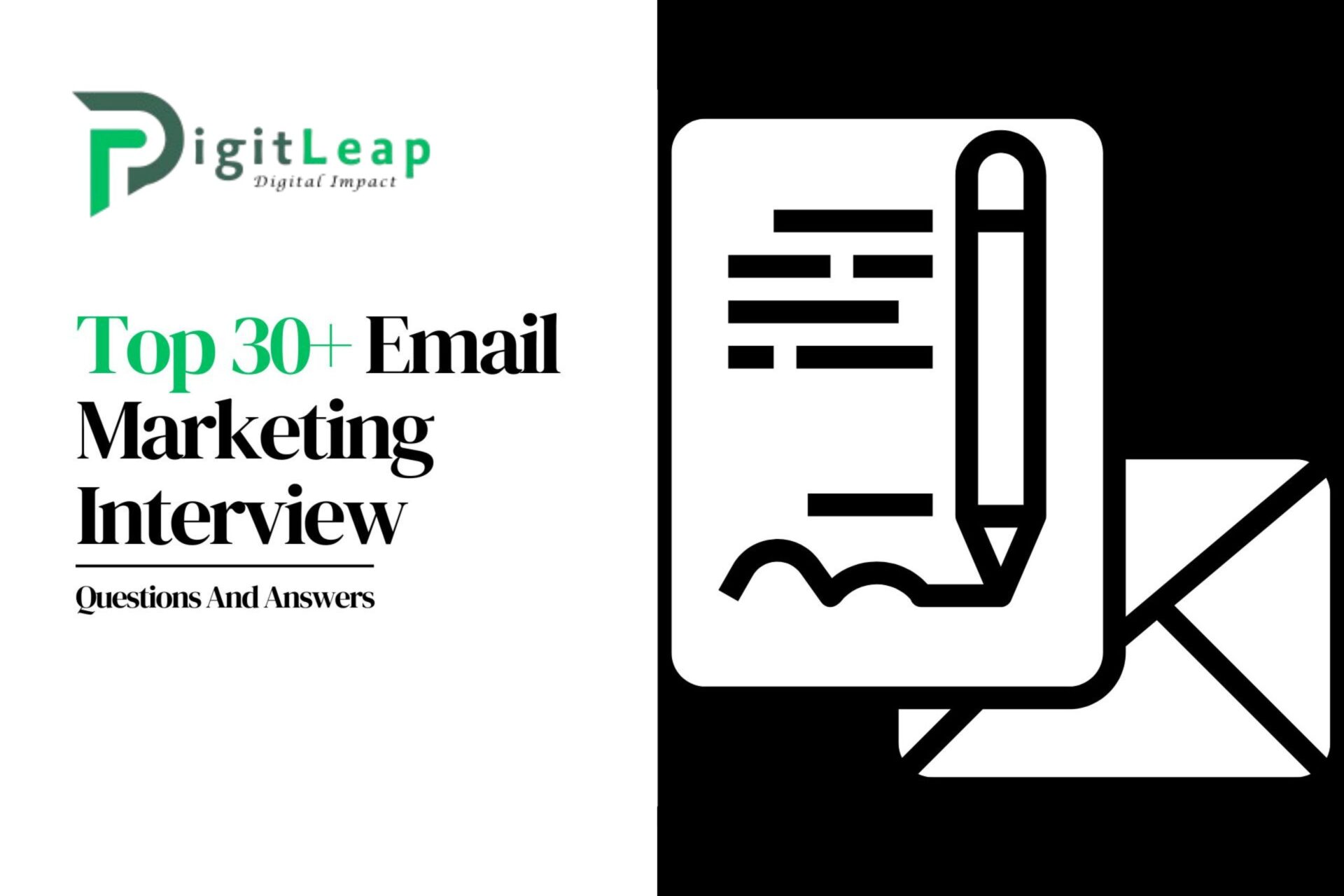Top 30 Email Marketing Interview Questions and Answers in 2024
1. What is email marketing, and why is it important?
Answer:
Email marketing involves sending targeted emails to a list of subscribers to promote products, services, or updates. It’s crucial because it provides a direct channel to communicate with customers, build relationships, and drive conversions. It often yields high ROI compared to other marketing channels.
2. What are the key components of an effective email marketing campaign?
Answer:
An effective email marketing campaign includes:
- Targeted Audience: Segmentation of the email list.
- Engaging Subject Line: Captures attention and encourages opens.
- Compelling Content: Valuable and relevant to the recipient.
- Call-to-Action (CTA): Clear instructions on what to do next.
- Personalization: Tailoring content based on user data.
- Analytics: Tracking performance metrics to refine strategies.
3. How do you build and maintain a quality email list?
Answer:
Build and maintain a quality email list by:
- Offering Incentives: E.g., discounts or free resources.
- Using Signup Forms: On your website or social media.
- Ensuring Compliance: With regulations like GDPR or CAN-SPAM.
- Regularly Cleaning the List: Removing inactive or invalid emails.
- Encouraging Engagement: Sending relevant content to keep subscribers interested.
4. What is A/B testing in email marketing?
Answer:
A/B testing involves sending two variations of an email to different segments of your audience to determine which version performs better. This can include testing subject lines, content, CTAs, or sending times to optimize email performance.
5. How do you measure the success of an email marketing campaign?
Answer:
Success can be measured through various metrics, including:
- Open Rate: Percentage of recipients who opened the email.
- Click-Through Rate (CTR): Percentage of recipients who clicked on a link.
- Conversion Rate: Percentage of recipients who completed a desired action.
- Bounce Rate: Percentage of emails that could not be delivered.
- Unsubscribe Rate: Percentage of recipients who opted out.
6. What is segmentation in email marketing, and why is it important?
Answer:
Segmentation involves dividing your email list into smaller groups based on criteria such as demographics, behavior, or purchase history. It’s important because it allows for more personalized and relevant content, improving engagement and conversion rates.
7. How do you handle unsubscribes and complaints?
Answer:
Handle unsubscribes and complaints by:
- Providing an Easy Opt-Out: Ensure the unsubscribe process is straightforward.
- Analyzing Feedback: Understand why subscribers are leaving and adjust strategies accordingly.
- Maintaining Compliance: Adhere to legal requirements for handling opt-outs and complaints.
8. What is a drip campaign, and how does it work?
Answer:
A drip campaign is a series of automated emails sent to subscribers over time based on their behavior or stage in the customer journey. It works by nurturing leads, guiding them through a funnel, and keeping them engaged with relevant content.
9. How do you ensure email deliverability?
Answer:
Ensure email deliverability by:
- Maintaining a Clean List: Regularly remove inactive or invalid addresses.
- Authenticating Your Domain: Using SPF, DKIM, and DMARC.
- Avoiding Spam Traps: Ensuring compliance with email best practices.
- Monitoring Deliverability Rates: Using tools to track and resolve issues.
10. What role does personalization play in email marketing?
Answer:
Personalization enhances engagement by tailoring content to the recipient’s preferences and behavior. This can include addressing the recipient by name, recommending products based on past purchases, or sending targeted offers based on location.
11. What are email marketing automation tools, and why are they useful?
Answer:
Email marketing automation tools streamline the process of sending emails based on triggers, such as user actions or predefined schedules. They are useful for creating personalized, timely communications and saving time on repetitive tasks.
12. How do you handle email marketing for mobile users?
Answer:
Handle email marketing for mobile users by:
- Optimizing for Mobile: Ensuring emails are mobile-responsive.
- Using Concise Content: Keeping text short and engaging.
- Testing Across Devices: Checking how emails render on different screens.
13. What is a welcome email, and why is it important?
Answer:
A welcome email is the first message sent to new subscribers or customers. It’s important because it sets the tone for future communications, provides initial value, and begins the process of building a relationship with the recipient.
14. How do you create an effective subject line for your emails?
Answer:
Create effective subject lines by:
- Being Clear and Specific: Indicate what the email is about.
- Creating Urgency: Use time-sensitive language.
- Personalizing: Include the recipient’s name or relevant details.
- Testing Variations: Use A/B testing to find what works best.
15. What are some common mistakes to avoid in email marketing?
Answer:
Common mistakes include:
- Neglecting Personalization: Failing to tailor content to the recipient.
- Ignoring Mobile Optimization: Sending emails that aren’t mobile-friendly.
- Overlooking Compliance: Not adhering to legal regulations.
- Sending Too Often: Bombarding recipients with excessive emails.
16. How do you handle email list segmentation?
Answer:
Handle email list segmentation by:
- Defining Segmentation Criteria: Such as behavior, demographics, or purchase history.
- Using Segmentation Tools: In your email marketing platform to create and manage segments.
- Testing and Adjusting Segments: Continuously refine based on performance and feedback.
17. What is an email funnel, and how is it used?
Answer:
An email funnel is a sequence of emails designed to guide subscribers through a journey, from awareness to conversion. It’s used to nurture leads, educate them about products or services, and drive them toward making a purchase.
18. How do you create engaging content for email campaigns?
Answer:
Create engaging content by:
- Understanding Your Audience: Tailor content to their interests and needs.
- Using Clear and Compelling Language: Make your message easy to understand and appealing.
- Incorporating Visuals: Use images and graphics to enhance engagement.
- Providing Value: Offer useful information, discounts, or exclusive content.
19. What are the best practices for designing email templates?
Answer:
Best practices for designing email templates include:
- Keeping It Simple: Avoid clutter and focus on key messages.
- Using Responsive Design: Ensure templates work well on all devices.
- Including Clear CTAs: Make it easy for recipients to take action.
- Testing Templates: Verify how they render across different email clients.
20. How do you handle email marketing compliance and regulations?
Answer:
Handle compliance by:
- Familiarizing Yourself with Laws: Such as GDPR, CAN-SPAM, and CASL.
- Providing Clear Opt-In/Opt-Out Options: Ensure subscribers can easily manage their preferences.
- Maintaining Accurate Records: Keep track of consent and preferences.
21. What are the benefits of using dynamic content in emails?
Answer:
Dynamic content allows you to tailor parts of an email based on recipient data, such as behavior or preferences. This enhances relevance, increases engagement, and improves the likelihood of conversion.
22. How do you use analytics to improve email marketing campaigns?
Answer:
Use analytics by:
- Tracking Key Metrics: Such as open rates, click-through rates, and conversions.
- Analyzing Trends: Identify what content or strategies perform best.
- Making Data-Driven Decisions: Adjust campaigns based on insights and performance data.
23. What is an email nurture sequence?
Answer:
An email nurture sequence is a series of emails sent to educate and build relationships with prospects over time. It’s designed to nurture leads through the sales funnel by providing valuable content and guidance.
24. How do you handle email marketing for e-commerce businesses?
Answer:
For e-commerce, handle email marketing by:
- Personalizing Offers: Based on purchase history and browsing behavior.
- Sending Cart Abandonment Emails: To recover lost sales.
- Promoting Special Offers: Such as discounts or seasonal sales.
25. What is the role of email automation in customer retention?
Answer:
Email automation helps retain customers by sending timely and relevant messages based on customer behavior, such as purchase follow-ups, loyalty rewards, and re-engagement campaigns.
26. How do you segment your email list for better targeting?
Answer:
Segment your email list by:
- Demographics: Age, gender, location.
- Behavior: Purchase history, website interactions.
- Engagement Level: Active vs. inactive subscribers.
- Preferences: Product interests or content types.
27. What is email drip marketing, and how is it implemented?
Answer:
Email drip marketing involves sending a series of pre-written emails to subscribers over time based on their actions or lifecycle stage. It’s implemented using automation tools that trigger emails based on user behavior or set intervals.
28. How do you ensure your emails are not marked as spam?
Answer:
Ensure your emails are not marked as spam by:
- Following Best Practices: Use a reputable email service provider.
- Avoiding Spammy Language: Steer clear of excessive use of capital letters or exclamation points.
- Maintaining a Clean List: Regularly update and remove invalid addresses.
29. What is the difference between a single opt-in and a double opt-in process?
Answer:
Single Opt-In: Users are added to the list immediately after signing up. Double Opt-In: Users must confirm their subscription by clicking a verification link sent to their email, ensuring higher quality and engagement rates.
30. How do you integrate email marketing with other digital marketing channels?
Answer:
Integrate email marketing by:
- Aligning Messaging: Ensure consistent messaging across email, social media, and other channels.
- Using Cross-Channel Data: Leverage data from other channels to personalize email content.
- Promoting Other Channels: Include links to your social media profiles or website in your emails.
These questions and answers cover a wide range of topics in email marketing, from basic concepts to advanced strategies. They should provide a solid foundation for preparing for an interview or enhancing your knowledge of email marketing.
Other Important Q&A List :
- OOPs Interview Questions And Answers
- SQL Interview Questions and Answers
- Content Writing Interview Questions and Answers
- Email Marketing Interview Questions and Answers
- Django Interview Questions and Answers
- C Programming Interview Questions and Answers
- ReactJS Interview Questions and Answers
- Angular Interview Questions and Answers
- Power BI Interview Questions and Answers
- Top DBMS Interview Questions and Answers
- Python Interview Questions and Answers
- MySQL Interview Questions and Answers
- Java Interview Questions and Answers
- Data Structures Interview Questions
- Flutter Interview Questions and Answers
- JavaScript Interview Questions and Answers
- PHP Interview Questions and Answers
- CSS Interview Questions and Answers
- HTML Interview Questions and Answers






